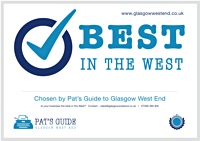Volunteers and All That.
Thanks to writer and artist Edward Chisnall for the following information about the Glasgow Volunteers.
Back in the Days of the First Empire when it was thought that Napoleon might variously invade the British isles via a tunnel, a series of gigantic balloons, or just by sailing over, among the many local defence forces raised to fight the French, groups were formed in Scotland to put down revolutionary fervour at home as well as abroad. Rumours abounded. For instance, in 1800 news spread like wildfire that discontented weavers were marching on the mansion of Lord President Campbell at Garscube to the west of Glasgow. The muster signal was a wooden rattle wielded by some eedjit rushing round the auld toon, and 300 ‘volunteers were hastily assembled.
By the time the armed forces of Glasgow arrived in the west end the trouble had drifted out of town. Sporadic rioting and acts of violence, like the burning of the Parish Records in Old Kilpatrick, were too far away to deal with comfortably. Anyway, the weather was excessively hot that year.
The Glasgow Volunteers disbanded after the Peace of Amiens in 1802, but were called back to the colours again. They included the Fifth or Grocer’s battalion, the Royal Glasgow Volunteer Horse, numbering sixty, although there seem to have been only twenty-eight horses. The Volunteers numbered over 5000 at their peak, Glasgow’s very own Home Guard of the Napoleonic era.
Incidentally, in the First World War 1n 1914 the Tramways Battalion numbered 5000 from Glasgow alone, and there also the ‘Bantams,’ malnutrition and history combining to create a population so diminutive that a regiment of men just over four feet tall was formed. But then, I remember the Argylls on station in Germany, were called ‘the poison dwarfs.’ Ok big man?
Edward C.







